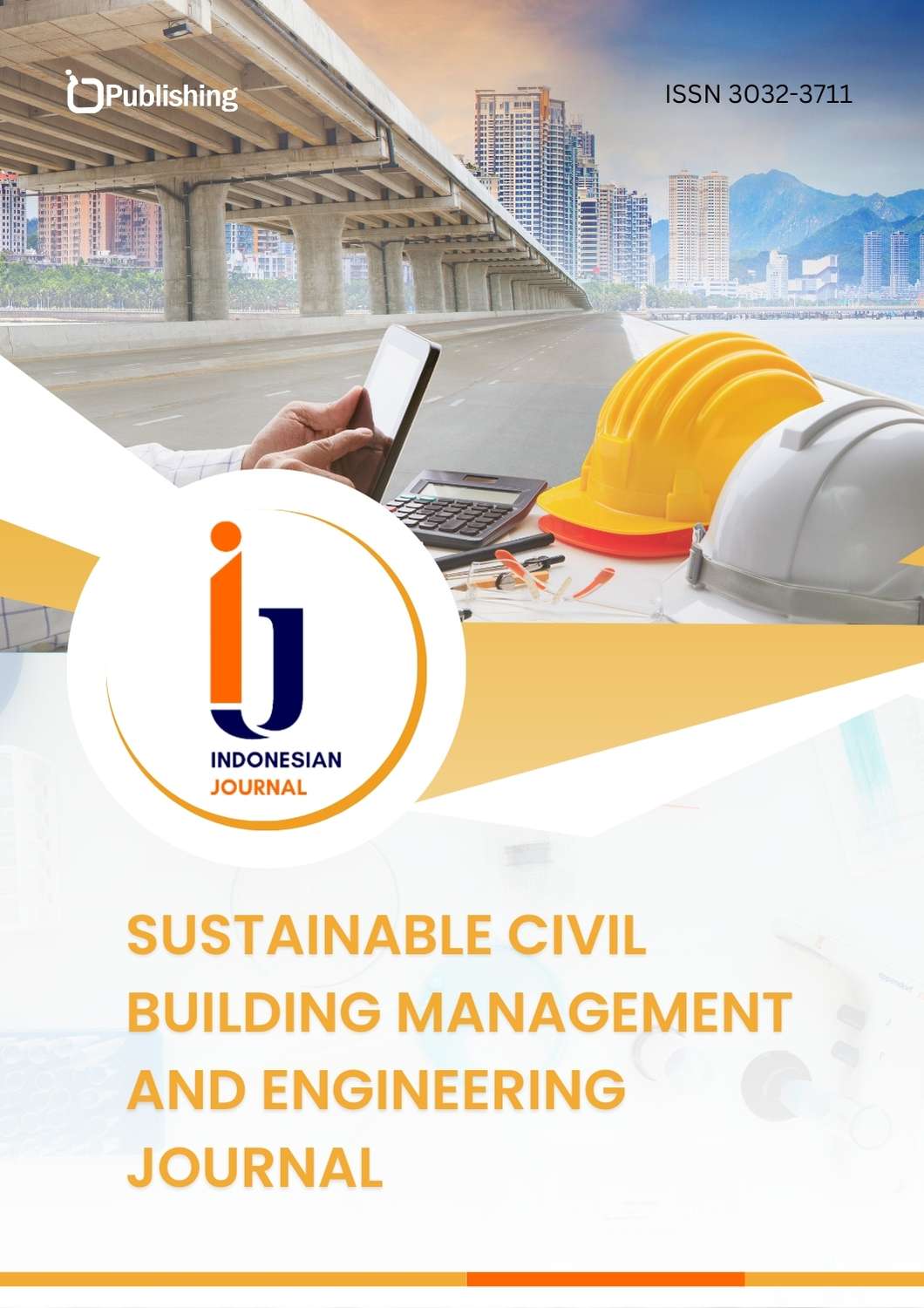Analysis of the Effect of Boro River Backwater as an Impact of Flood Inundation in Sewu Urban Village, Surakarta City
DOI:
https://doi.org/10.47134/scbmej.v2i2.3759Keywords:
Backwater, Flood Inundation, HEC-RASAbstract
Backwater is a condition where the flow of river water is obstructed, causing the water level to rise and overflow into the surrounding area. The backwater phenomenon is the main cause of flood inundation in Sewu Village. The confluence of two rivers, namely the main Bengawan Solo River and the Boro River, causes the flow of water from the Boro River to be obstructed due to the higher elevation of the River in the Bengawan Solo River. Therefore, this study aims to analyze the effect of the Boro River backwater on flood inundation in Sewu Village with a 20-year (Q20), 25-year (Q25), and 50-year (Q50) return period flood discharge using the Soil Conservation Service synthetic unit hydrograph method with HEC-HMS software. This research uses hydraulic simulation by simulating river flow to find out the location of backwater that causes runoff. The results showed that the 20-year return period flood discharge (Q20) of 12.3 m³/s, 25-year return period (Q25) of 12.8 m³/s, and 50-year return period (Q50) of 14.4 m³/s significantly affected the water level in Boro River, which resulted in an increase in the flood inundation area in Sewu Village. Hydraulic simulations revealed that the critical point of backwater in Boro River affects the maximum water depth of the river, such as the 20-year return period (Q20) has an increase difference of 0.40 meters, the 25-year return period (Q25) of 0.32 meters, and the 50-year return period (Q50) of 0.45 meters.
References
Alaghmand, S., Abdullah, R. bin, Abustan, I., & Vosoogh, B. (2010). GIS-based river flood hazard mapping in urban area (a case study in Kayu Ara river basin, Malaysia). International Journal of Engineering and Technology, 2(6), 488–500.
Amin, M., Ir Ridwan, Ms., Ir Iskandar Zulkarnaen, M., & Jurusan Teknik Pertanian, Ms. (2018). Pengolahan Daerah Aliran Sungai. LPPM UNILA Institutional Repository (LPPM-UNILA-IR), 9–92. http://repository.lppm.unila.ac.id/id/eprint/8538
Andina, E. (2019). The Analysis of Waste Sorting Behavior in Surabaya. Jurnal Aspirasi, 10(2), 119–138. https://doi.org/10.22212/aspirasi.v10i2.1424
Anna, A. N., Cholil, M., Studi, P., Geografi, P., & Surakarta, U. M. (2015). Terhadap Banjir Luapan Sungai Bengawan Solo Hulu Tengah Pendahuluan The 2 nd University Research Coloquium 2015 ISSN 2407-9189. The 2nd University Research Coloquium.
Basuki, Winaesih. I., & Adhyani,. N. L. (2009). Analisis Periode Ulang Hujan Maksimum Dengan Berbagai Metode (J.Agromet).
Bessar, M. A., Matte, P., & Anctil, F. (2020). Uncertainty analysis of a 1D river hydraulic model with adaptive calibration. Water (Switzerland), 12(2). https://doi.org/10.3390/w12020561
Chen, Y., Xia, R., Jia, R., Hu, Q., Yang, Z., Wang, L., Zhang, K., Wang, Y., & Zhang, X. (2023). Flow backward alleviated the river algal blooms. Water Research, 245(September), 120593. https://doi.org/10.1016/j.watres.2023.120593
Clark, M. J. (1998). Putting water in its place: a perspective in GIS in hydrology an water management. Hydrological Processes, 12.
Dwiprayogo, B., Sisinggih, D., & Priyantoro, D. (2018). Studi Perencanaan Tanggul Banjir Di Sungai Bengawan Solo Pada Ruas Kota Surakarta, Jawa Tengah. Jurnal Pengairan, 1–9.
Dyhouse, G. R. (1985). Stage‐Frequency Analysis at a Major River Junction. Journal of Hydrology Engineering, 565–583. https://doi.org/10.1061/(ASCE)0733-9429(1985)111:4(565
Erstayudha, N., Hadi, P., & Suprayogi, S. (2016). Model Pemanenan Air Hujan (Rainwater Harvesting) untuk Mengurangi Dampak Bencana Banjir di DAS Penguluran, Kecamatan Sumbermanjing Wetan Kabupaten Malang. Thesis, September. https://doi.org/10.13140/RG.2.2.21587.58406
Goel, N. K., Than, H., & Arya, D. S. (2005). Flood Hazard Mapping In The Lower Part Of Chindwin River Basin. International Conference on Innovation Advances and Implementation of Flood Forecasting Technology. Tromsø, Norway.
Harto B. S. (2000). Hidrologi: teori, masalah, penyelesaian (Hydrology, theory-problem-solution).
Khan, H. U. A., Khalil, S. F. A., Kazmi, S. J. H., Umar, M., Shahzad, A., & Farhan, S. Bin. (2017). Identification of River Bank Erosion and Inundation Hazard Zones Using Geospatial Techniques – a Case Study of Indus River Near Layyah District, Punjab, Pakistan. Geoplanning: Journal of Geomatics and Planning, 4(2), 121. https://doi.org/10.14710/geoplanning.4.2.121-130
Khan, S., Ncibi, K., Hamdi, N., & Hamed, Y. (2022). Flood Analysis Using HEC-RAS and HEC-HMS : A Case Study. Water, 14(3779), 1–19.
Martin, O., Rugumayo, A., & Ovcharovichova, J. (2012). Application of HEC-HMS / RAS and GIS Tools in Flood Modeling : A Case Study for River Sironko –Uganda. Global Journal of Engineering, Design & Technology, 19–31.
Pabalik, I., Ihsan, N., & Arsyad, M. (2015). Analisis Fenomena Perubahan Iklim dan Karakteristik Curah Hujan Ekstrim di Kota Makassar. Jurnal Sains Dan Pendidikan Fisika, 11(1), 88–92.
Peraturan Menteri PU RI No12/PRT/M/ 2014. (2014). Peraturan Menteri PU RI No12/PRT/M/ 2014. Tentang Penyelenggaraan Sistem Drainase Perkotaan, 1–18.
Rahman, G., Atta-ur-Rahman, Samiullah, & Dawood, M. (2018). Spatial and temporal variation of rainfall and drought in Khyber Pakhtunkhwa Province of Pakistan during 1971–2015. Arabian Journal of Geosciences, 11(3), 46. https://doi.org/10.1007/s12517-018-3396-7
Sachs, L. (1984). Applied Statistics: A Handbook of Techniques.
Samarasinghe et al. (2010). Application of Remote Sensing and GIS for Flood Risk Analysis: A Case Study at Kalu-Ganga River, Sri Lanka. International Archives of the Photogrammetry, Remote Sensing and Spatial Information Science, Volume XXXVIII, Part 8, Kyoto Japan, 110–115.
Santosa, P. B. (2006). River flow prediction and floodplain mapping using Artificial Neural Networks and GIS. International Symposium & Exhibition on Geoinformation 2006, Malaysia, 1–7. https://repository.ugm.ac.id/276104/
Shen, X., Li, S., Sun, S., Qing, D., Li, D., Wang, K., Gao, W., & Cao, L. (2023). The mechanism of dissolved oxygen mixing and atmospheric reoxygenation at the confluence with different flow ratios and junction angles. Journal of Hydrology, 626(PA), 130191. https://doi.org/10.1016/j.jhydrol.2023.130191
Soewarno. (1995). Hidrologi Aplikasi Metode Statistik Untuk Analisa Data. Penerbit Nova.
Soewarno. (2014). Aplikasi metode Statistika Untuk Analisis Data Hidrologi. Graha Ilmu.
Suryanti, I., Nyoman Harry Juliarthana, I., Ayu Sari Galih, K., & Putu Wahyu Wedanta Pucangan, I. (2023). Kajian Topografi dan Hidrologi Sempadan Sungai Tukad Oos Kabupaten Bangli-Gianyar. Open Access, 6(1), 36–49.
Syamsuddin, A. P., Musa, R., & Ashad, H. (2022). Kajian Pengaruh Parameter Hidrograf Satuan Sintetik Berdasarkan Karakteristik Daerah Aliran Sungai. Jurnal Teknik Sipil MACCA, 7(1), 50–56. https://doi.org/10.33096/jtsm.v7i1.541
Tang, X., Li, R., Wu, M., Zhao, W., Zhao, L., Zhou, Y., & Bowes, M. J. (2019). Influence of turbid flood water release on sediment deposition and phosphorus distribution in the bed sediment of the Three Gorges Reservoir, China. Science of the Total Environment, 657, 36–45. https://doi.org/10.1016/j.scitotenv.2018.12.011
Triatmodjo, B. (2008). Hidrologi terapan (Applied hydrology). Beta Offset.
Triatmodjo, B. (2013). Hidrologi Terapan. Beta Offset.
Tsakiris, G. (2014). Flood risk assessment: Concepts, modelling, applications. Natural Hazards and Earth System Sciences, 14(5), 1361–1369. https://doi.org/10.5194/nhess-14-1361-2014
Weber, H, P. M. (1988). Possible Contributions of Hydroinformatics to Risk Analysis in Insurance. Proceedings of the Second International Conference on Hydroinformatics, 57–62. https://doi.org/ISBN 90 5410 825 5
Downloads
Published
How to Cite
Issue
Section
License
Copyright (c) 2025 Syakira Madina Noor Amina, Rr. Rintis Hadiani, Solichin

This work is licensed under a Creative Commons Attribution 4.0 International License.










